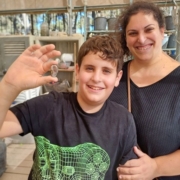Find and Finders of the Month — the Gross Family Found a Pierced Stone Vessel Fragment

During the last summer, we were overwhelmed by the number of visitors and archaeological work. We had hoped to catch up on missed posts during the winter, but then a war broke out…
So, meet (slightly belatedly) the Gross family from Leeds, UK, who visited us this past summer and found a fragment of a chalk stone vessel.
People worldwide have made stone vessels for a variety of reasons and in a variety of periods, ranging from prehistoric times, when stone was the only available hard raw material, to modern times, when stone is usually selected mainly for its artistic value.
However, making a vessel out of stone is no simple task. The archaeological record shows that once alternatives like pottery or metal became available, stone vessels become much less common.
Yet, in the late Second Temple period (1st century BCE – 1st century CE), stone vessels enjoyed a rise in popularity. Archaeologists excavating throughout the country find plenty of them – so much so that “Jerusalemite/Judean stone vessels” have become a well-known group of vessel types. Some were ornate, but most, like the fragment found by the Gross family, were plain vessels made of soft chalk stone – the type of vessels any sensible person would have made from clay for a fraction of the effort.
So, why did such seemingly impractical vessels gain popularity? The answer can be found in the Torah (Numbers 31, and elsewhere), which gives instructions on dealing with impurity contracted by various types of vessels but leaves stone vessels out of the list – making them perfect for someone looking for a vessel that does not contract ritual impurity.
The interesting thing about this particular fragment is the hole drilled through it. We can think of a few possible reasons, some perhaps more likely than others:
- Some laws of purity dictate punching a hole through an impure vessel – similar laws apply to some vessels used to cook sacrificial meat. Indeed, such vessels have been discovered in archaeological excavations in Jerusalem, but those laws refer specifically to ceramic vessels, so that can’t be the case here.
Pierced stone vessels are uncommon, so why did someone drill through this one?
- Our fragment only has one hole, so it’s probably not a strainer, and it doesn’t look like much of an amulet either.
- It’s possible that after the original vessel broke, this fragment was used as an anvil or a drill block, and the hole we see was created when a soft material, such as leather or wood, was laid over it to be drilled through.
- Another possibility is that we see a repair hole. These repair holes are uncommon, since repairing ceramic and chalk vessels often involved more effort than making or acquiring new ones. However, broken vessels with fragments that had holes drilled in them and were tied back together do exist. Unfortunately, unless we find a vessel fragment with a matching hole, we’ll never be able to say for sure.
Or maybe the hole was drilled for a completely different purpose. Do you have any good suggestions?

Discover more from The Temple Mount Sifting Project
Subscribe to get the latest posts sent to your email.












Is it possible to receive copy of my photo with my find 6 Feb 2024
Receipt: 501486
Registered ID: 580594794
Toda,
Steve Shaw
sending you an e-mail now.